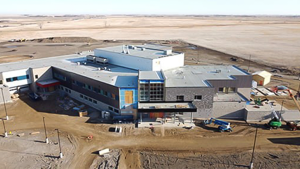A large salt cavern in eastern Alberta that will store excess wind energy, in the form of compressed air, for future electricity use could be a Canadian first.
Calgary-based Rocky Mountain Power has been working on the Alberta Saskatchewan Intertie Storage Project (ASISt) for a couple of years.
Company president Jan van Egteren said because of regulatory procedures, it’ll likely be another two or three years before the company actually breaks ground on the project.
While using salt caverns for storage purposes is not new – they are often used to store liquid petroleum products such as butane, as well as the by products of oil production.
What is new is employing the caverns to store wind energy.
"This is groundbreaking not so much in the sense of creating the caverns, but that they’ll be used in a different way, in an industry that’s not used them before," van Egteren explained.
"There has never been power storage in Canada using salt caverns"
The cavern will be built near Lloydminster – a city that straddles the Alberta/Saskatchewan border – because of the salt bed underlying the area, as well as its location.
It is in close proximity to both the Alberta and Saskatchewan power grids.
"We would like to provide a storage facility for both the western and eastern grids," said van Egteren, adding Rocky Mountain Power’s initial plan for the area was, actually, to install a back-to-back DC converter transmission system.
However, there were challenges.
"We realized it might make more sense to put a storage field in there instead of trying to move power instantaneously between the grids," he said, adding that a storage facility is, simply another way of creating an interconnection between grid systems.
Van Egteren said one reason salt caverns haven’t been used to store power in Canada before is because there hasn’t been that much wind attached to the grid in the past."
"If we want more renewable energy, we’ll have to back it up. The best way of doing this is to have storage facilities like we are creating, otherwise the grid will have instability," he explained.
Salt caverns are only one option for energy storage.
There are others, each with their own pros and cons, including pump hydro storage and batteries.
Pump hydro storage involves pumping water from a lower reservoir to a higher one.
The energy is released when the water flows back down to the lower reservoir through a turbine, generating electricity in the process.
However, van Egteren pointed out, pump hydro storage doesn’t work well in flat areas.
While batteries have rapid response times, they’re not effective for lengthy durations.
Creating salt caverns is not new for Rocky Mountain Power.
The company has built a number of them already throughout the Prairie provinces and van Egteren describes the process as fairly straightforward.
A wellbore system drills into the salt bed.
Water is then pushed down into the salt to dissolve it.
The salt-saturated water is pumped back to the surface and, in this case, will be pumped back down into naturally-occurring saline aquifers nearby.
When complete, the cavern will have a diameter of about 60 metres and a height of 80 metres, dimensions determined by the thickness of the salt bed.
The self-sealing properties of salt are key to the success of the storage facility.
Unlike rock, a salt cavern is impermeable, preventing any of the stored energy from escaping.
A series of compressors near the salt cavern – operated by wind-generated electricity – will take surrounding air, compress it and pump it underground into the cavern to store for future use.
Van Egteren estimated that the storage facility, near Lloydminster, will be able to store enough energy to generate electricity for a city the size of Red Deer for five days.
Van Egteren said he believes power storage is the way of the future.
He added that it will become much more common over the next decade, whether via batteries, compressed air storage or pump hydro.











Recent Comments
comments for this post are closed